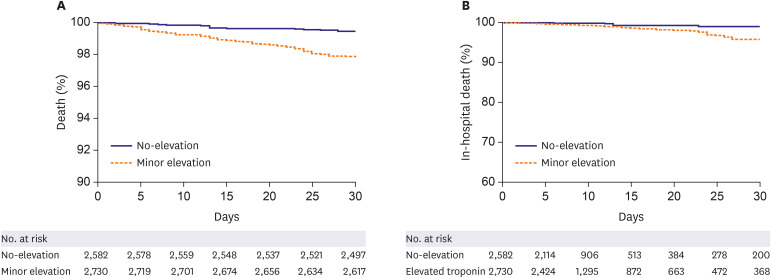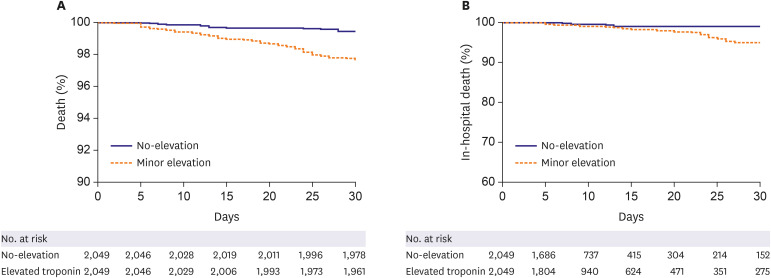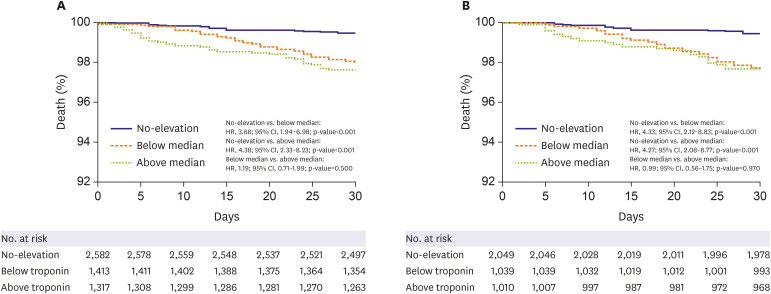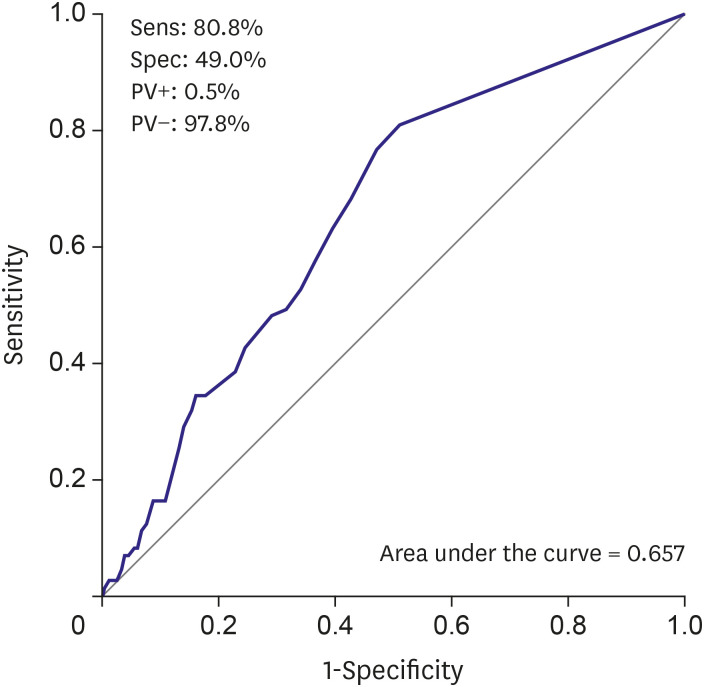Korean Circ J.
2020 Oct;50(10):925-937. 10.4070/kcj.2020.0088.
Mildly Elevated Cardiac Troponin below the 99th-Percentile Upper Reference Limit after Noncardiac Surgery
- Affiliations
-
- 1Department of Anesthesiology and Pain Medicine, Samsung Medical Center, Sungkyunkwan University School of Medicine, Seoul, Korea
- 2Division of Cardiology, Department of Medicine, Heart Vascular Stroke Institute, Samsung Medical Center, Sungkyunkwan University School of Medicine, Seoul, Korea
- 3Center for Health Promotion, Samsung Medical Center, Sungkyunkwan University School of Medicine, Seoul, Korea
- 4Department of Emergency Medicine, Samsung Medical Center, Sungkyunkwan University School of Medicine, Seoul, Korea
- 5Department of Emergency Medicine, Samsung Medical Center, Sungkyunkwan University School of Medicine, Seoul, Korea
- 6Department of Emergency Medicine, Samsung Medical Center, Sungkyunkwan University School of Medicine, Seoul, Korea
- KMID: 2507010
- DOI: http://doi.org/10.4070/kcj.2020.0088
Abstract
- Background and Objectives
In patients with perioperative cardiac troponin (cTn) I below the 99th-percentile upper range of limit (URL), mortality according to cTn I level has not been fully evaluated. This study evaluated the association between postoperative cTn I level above the lowest limit of detection but within the 99th-percentile URL and 30-day mortality after noncardiac surgery.
Methods
Patients with cTn I values below the 99th-percentile URL during the perioperative period were divided into a no-elevation group with cTn I at the lowest limit of detection (6 ng/L) and a minor elevation group with cTn I elevation below the 99th percentile URL (6 ng/L < cTn I < 40 ng/L). The primary outcome was 30-day mortality.
Results
Of the 5,312 study participants, 2,582 (48.6%) were included in the no-elevation group and 2,730 (51.4%) were included in the minor elevation group. After propensity scorematching, the minor elevation group showed significantly increased 30-day mortality (0.5% vs. 2.3%; hazard ratio, 4.30; 95% confidence interval, 2.23–8.29; p<0.001). The estimated cutoff value of cTn I to predict 30-day mortality was 6 ng/L with the area under the receiver operating characteristic curve 0.657.
Conclusions
A mild elevation of cTn I within the 99th-percentile URL after noncardiac surgery was significantly associated with increased 30-day mortality as compared with the lowest limit of detection.
Keyword
Figure
Reference
-
1. Ford I, Shah AS, Zhang R, et al. High-sensitivity cardiac troponin, statin therapy, and risk of coronary heart disease. J Am Coll Cardiol. 2016; 68:2719–2728. PMID: 28007133.2. Omland T, de Lemos JA, Sabatine MS, et al. A sensitive cardiac troponin T assay in stable coronary artery disease. N Engl J Med. 2009; 361:2538–2547. PMID: 19940289.
Article3. Zimmerman AM, Marwaha J, Nunez H, et al. Preoperative myocardial injury as a predictor of mortality in emergency general surgery: an analysis using the American College of Surgeons NSQIP database. J Am Coll Surg. 2016; 223:381–386. PMID: 27163647.
Article4. Haider DG, Klemenz T, Fiedler GM, Nakas CT, Exadaktylos AK, Leichtle AB. High sensitive cardiac troponin T: testing the test. Int J Cardiol. 2017; 228:779–783. PMID: 27888755.
Article5. Writing Committee for the VISION Study Investigators. Devereaux PJ, Biccard BM, et al. Association of postoperative high-sensitivity troponin levels with myocardial injury and 30-day mortality among patients undergoing noncardiac surgery. JAMA. 2017; 317:1642–1651. PMID: 28444280.6. Twerenbold R, Badertscher P, Boeddinghaus J, et al. 0/1-hour triage algorithm for myocardial infarction in patients with renal dysfunction. Circulation. 2018; 137:436–451. PMID: 29101287.7. Sessler DI, Devereaux PJ. Perioperative troponin screening. Anesth Analg. 2016; 123:359–360. PMID: 27331782.
Article8. Giannitsis E, Steen H, Kurz K, et al. Cardiac magnetic resonance imaging study for quantification of infarct size comparing directly serial versus single time-point measurements of cardiac troponin T. J Am Coll Cardiol. 2008; 51:307–314. PMID: 18206741.
Article9. Lønborg J, Vejlstrup N, Kelbæk H, et al. Final infarct size measured by cardiovascular magnetic resonance in patients with ST elevation myocardial infarction predicts long-term clinical outcome: an observational study. Eur Heart J Cardiovasc Imaging. 2013; 14:387–395. PMID: 23178864.10. Thygesen K, Alpert JS, Jaffe AS, et al. Fourth universal definition of myocardial infarction (2018). J Am Coll Cardiol. 2018; 72:2231–2264. PMID: 30153967.
Article11. van der Linden N, Klinkenberg LJ, Bekers O, et al. Prognostic value of basal high-sensitive cardiac troponin levels on mortality in the general population: a meta-analysis. Medicine (Baltimore). 2016; 95:e5703. PMID: 28033267.12. Lee AY, Kamphuisen PW, Meyer G, et al. Tinzaparin vs warfarin for treatment of acute venous thromboembolism in patients with active cancer: a randomized clinical trial. JAMA. 2015; 314:677–686. PMID: 26284719.13. Kristensen SD, Knuuti J. New ESC/ESA Guidelines on non-cardiac surgery: cardiovascular assessment and management. Eur Heart J. 2014; 35:2344–2345. PMID: 25104785.
Article14. Machado MN, Nakazone MA, Maia LN. Acute kidney injury based on KDIGO (Kidney Disease Improving Global Outcomes) criteria in patients with elevated baseline serum creatinine undergoing cardiac surgery. Rev Bras Cir Cardiovasc. 2014; 29:299–307. PMID: 25372901.
Article15. Ribbing J, Nyberg J, Caster O, Jonsson EN. The lasso--a novel method for predictive covariate model building in nonlinear mixed effects models. J Pharmacokinet Pharmacodyn. 2007; 34:485–517. PMID: 17516152.
Article16. Latouche A, Porcher R, Chevret S. Sample size formula for proportional hazards modelling of competing risks. Stat Med. 2004; 23:3263–3274. PMID: 15490425.
Article17. VanderWeele TJ, Ding P. Sensitivity analysis in observational research: introducing the E-value. Ann Intern Med. 2017; 167:268–274. PMID: 28693043.
Article18. Puelacher C, Lurati Buse G, Seeberger D, et al. Perioperative myocardial injury after noncardiac surgery: incidence, mortality, and characterization. Circulation. 2018; 137:1221–1232. PMID: 29203498.19. Vascular Events In Noncardiac Surgery Patients Cohort Evaluation (VISION) Study Investigators. Devereaux PJ, Chan MT, et al. Association between postoperative troponin levels and 30-day mortality among patients undergoing noncardiac surgery. JAMA. 2012; 307:2295–2304. PMID: 22706835.
Article20. Smilowitz NR, Redel-Traub G, Hausvater A, et al. Myocardial injury after noncardiac surgery: a systematic review and meta-analysis. Cardiol Rev. 2019; 27:267–273. PMID: 30985328.
Article21. Devereaux PJ, Szczeklik W. Myocardial injury after non-cardiac surgery: diagnosis and management. Eur Heart J. Forthcoming. 2019.
Article22. Keller T, Hamm CW. High-sensitivity cardiac troponin assays: finally ready for prime time? Nat Rev Cardiol. 2019; 16:135–136. PMID: 30464204.
Article23. Mariathas M, Allan R, Ramamoorthy S, et al. True 99th centile of high sensitivity cardiac troponin for hospital patients: prospective, observational cohort study. BMJ. 2019; 364:l729. PMID: 30867154.
Article24. Gillmann HJ, Meinders A, Grohennig A, et al. Perioperative levels and changes of high-sensitivity troponin T are associated with cardiovascular events in vascular surgery patients. Crit Care Med. 2014; 42:1498–1506. PMID: 24584063.
Article25. Niizuma S, Iwanaga Y, Yahata T, Miyazaki S. Renocardiovascular biomarkers: from the perspective of managing chronic kidney disease and cardiovascular disease. Front Cardiovasc Med. 2017; 4:10. PMID: 28321399.
Article26. Park J, Lee SH, Han S, et al. Elevated high-sensitivity troponin I during living donor liver transplantation is associated with postoperative adverse outcomes. Transplantation. 2018; 102:e236–44. PMID: 29298237.
Article27. Beckman JA. Postoperative troponin screening: a cardiac Cassandra? Circulation. 2013; 127:2253–2256. PMID: 23667269.28. Sandoval Y, Smith SW, Apple FS. Present and future of cardiac troponin in clinical practice: a paradigm shift to high-sensitivity assays. Am J Med. 2016; 129:354–365. PMID: 26743351.
Article29. Thygesen K, Alpert JS, Jaffe AS, et al. Fourth universal definition of myocardial infarction (2018). Eur Heart J. 2019; 40:237–269.
Article
- Full Text Links
- Actions
-
Cited
- CITED
-
- Close
- Share
- Similar articles
-
- Subclinical and Tiny Myocardial Injury within Upper Reference Limit of Cardiac Troponin Should Not Be Ignored after Noncardiac Surgery
- The Role of Cardiac Biomarkers in the Diagnosis and Management of Patients Presenting with Suspected Acute Coronary Syndrome
- Clinical Significance of Minor Elevation of Cardiac Troponin I
- Analytical Characteristics of High-Sensitivity Cardiac Troponin Assays
- Absolute Change in High-Sensitivity Cardiac Troponin I at Three Hours After Presentation is Useful for Diagnosing Acute Myocardial Infarction in the Emergency Department





